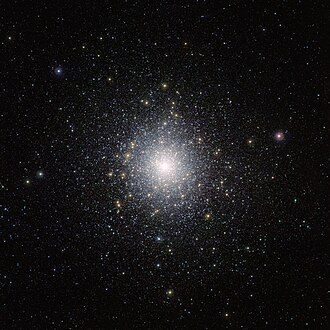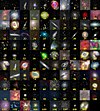47 Tucanae
|
Globular cluster 47 Tucanae |
|
|---|---|

|
|
| Recorded with the VISTA | |
| AladinLite | |
| Constellation | Toucan |
|
Position equinox : J2000.0 , epoch : J2000.0 |
|
| Right ascension | 00 h 24 m 05.67 s |
| declination | -72 ° 04 ′ 52.6 ″ |
| Appearance | |
| Concentration class | III |
| Brightness (visual) | 4.91 mag |
| Brightness (B-band) | 5.78 likes |
| Angular expansion | 30.9 ′ |
|
Color excess E (BV) (redness) |
0.037 mag |
| Physical data | |
| Affiliation | Milky Way |
| Integrated spectral type | G4 |
| Redshift | −0.000062 ± 0.000001 |
| Radial velocity | (−18.7 ± 0.2) km / s |
| distance | about 17100 Lj (about 5000 pc ) |
| diameter | 120 ly |
| Age | 10 billion years |
| history | |
| discovery | Nicolas Louis de Lacaille |
| Discovery date | 1751 |
| Catalog names | |
| NGC 104 • C 0021-723 • GCl 1 • ESO 50-SC9 • Mel 1 • Dun 18 • GC 52 • 47 Tucanae • ξ Tucanae • Lac 1 • h 2322 | |
47 Tucanae (also known as NGC 104 ) is the second brightest globular cluster in the sky after Omega Centauri and can be seen as a small nebula with the naked eye. It's a particularly large, old cluster and about 15,000 light-years from Earth.
Discovery and naming
The name 47 Tucanae comes from the fact that the star cluster was initially regarded as a star due to its compact appearance and great apparent brightness and was named accordingly. Further investigated has it first in 1751 the French astronomer Nicolas Louis de Lacaille .
Location and characteristics

Seen from Earth, 47 Tucanae appears to be right next to the Small Magellanic Cloud , which, however, is many times further away. It is only visible from the southern hemisphere. With an apparent diameter of 30 ′ , it has a brightness of 4.9 mag. Within a diameter of approx. 120 light years, the star cluster houses several million stars, including several red giants . In the center of the cluster, the stars are very densely packed and some are less than 0.1 light-years apart.
Long-term observations with the Fermi Gamma-ray Space Telescope reveal 47 Tucanae as a weak source of gamma radiation, which is presumably generated by millisecond pulsars .
Web links
- Astronews
- Hubble Space Telescope
- Chandra
- Globular Cluster 47 Tucanae - Astronomy Picture of the Day from April 22, 2001 (English).
- Globular Cluster 47 Tucanae from SALT - Astronomy Picture of the Day from September 5, 2005 (English).
- SEDS
- Alpha Tucanae
Individual evidence
- ↑ a b c SIMBAD query
- ↑ Harlow Shapley, Helen B. Sawyer: A Classification of Globular Clusters . In: Harvard College Observatory Bulletin . tape 849 , 1927, pp. 11-14 , bibcode : 1927BHarO.849 ... 11S .
- ^ A b Students for the Exploration and Development of Space
- ↑ NASA / IPAC Extragalactic Database
- ↑ http://iopscience.iop.org/0004-637X/533/1/215/pdf/0004-637X_533_1_215.pdf
- ↑ http://www.eso.org/public/germany/news/eso1302/
- ↑ 47 Tuc - a large globular cluster - Astronomy Picture of the Day from August 26, 2008.
- ↑ X-Ray Stars of 47 Tuc - Astronomy Picture of the Day of July 21, 2005 (English).
- ↑ Fermi's Gamma-Ray Sky - Astronomy Picture of the Day of March 21, 2009.
